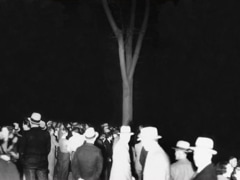
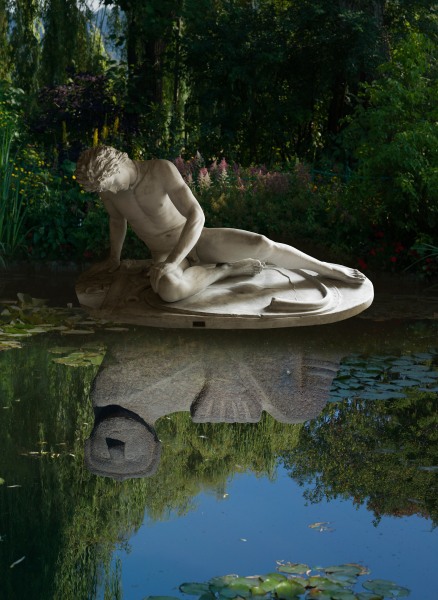
Ken Gonzales-Day
Reflection (Digital Composition with Plaster Copy of Roman Copy, Dying Gaul, Royal Cast Collection, Copenhagen; Mesoamerican, Chac Mool, National Museum of Anthropology, Mexico City; Monet’s House and Garden, Giverny), 2025
Archival ink on rag paper
55 x 40 in (139.7 x 101.6 cm)
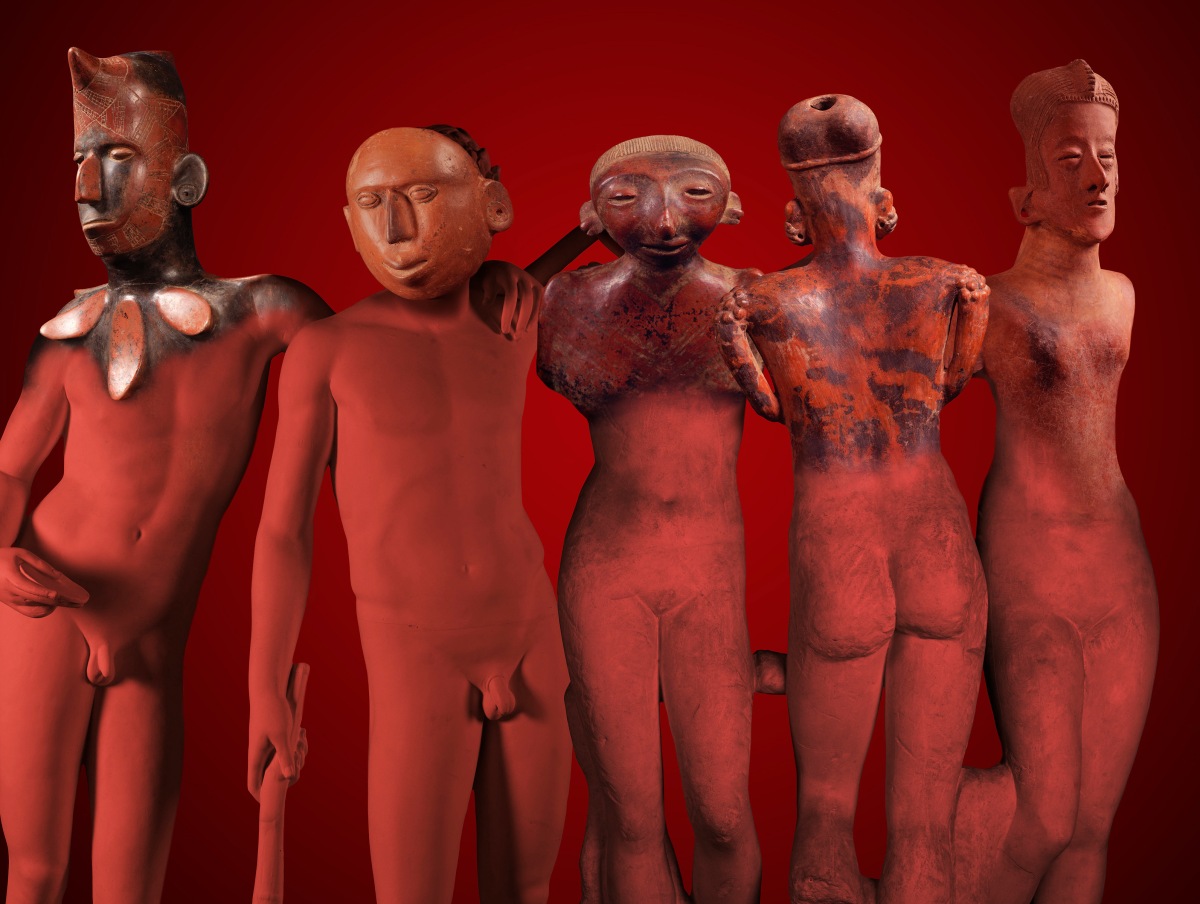
Ken Gonzales-Day
Red Figures (Digital composition with, Mexico, Colima, Seated Figure, Dog with Human Mask; Mexico, Nayarit Seated Female Figure, Seated Female Figure; Mexico, Colima, Coahuayana Valley, Seated Female on Bench, all LACMA; Plaster of Roman, Castor and Pollux; Royal Cast Collection, Copenhagen; Plaster of Roman Copy of Three Graces, Royal Cast Collection, Copenhagen), 2025
Archival ink on rag paper
40 x 53 in (101.6 x 134.6 cm)
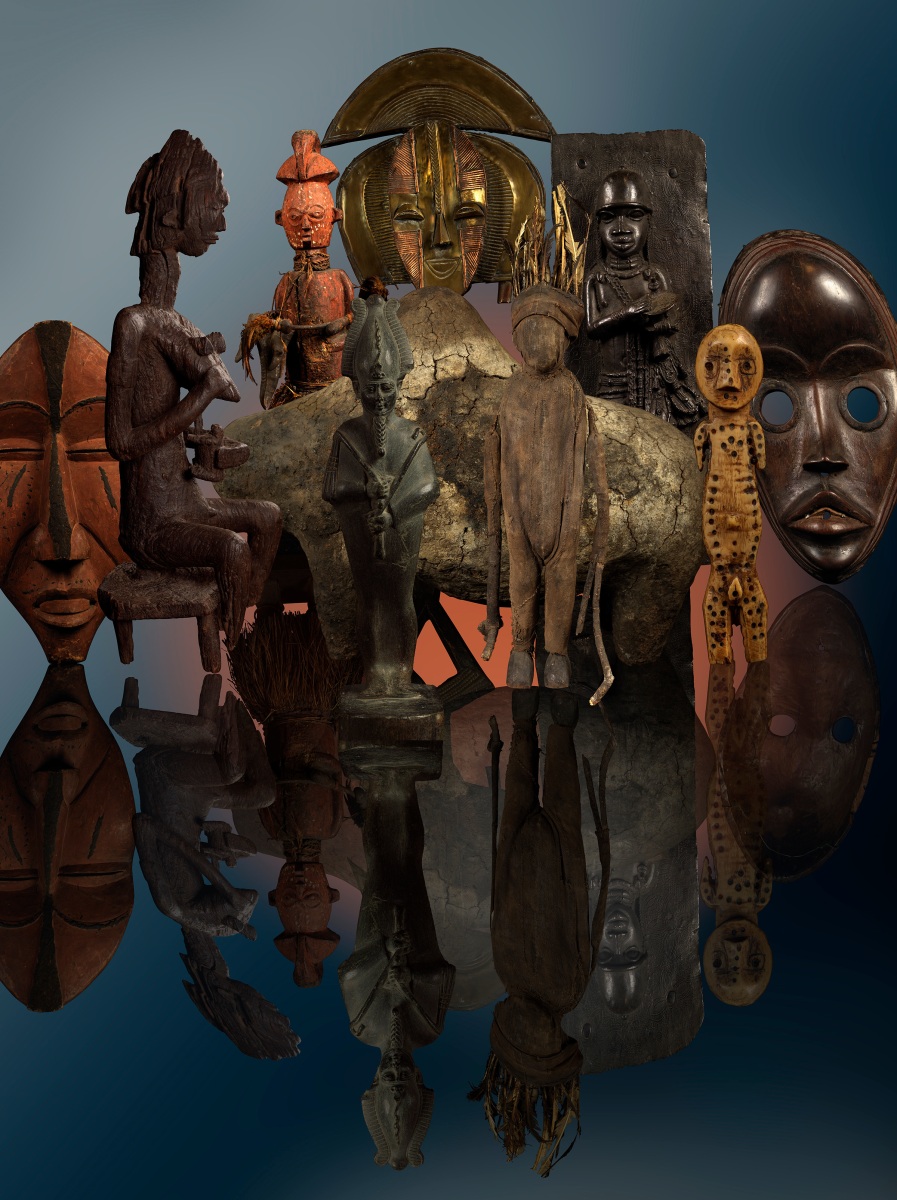
Ken Gonzales-Day
Africa (Digital composition with Africa, Democratic Republic of the Congo, Mask; Mali, Mother and Child Figure for the Gwan Association; Africa, Democratic Republic of the Congo, Figure of Hunter; Africa, Gabon, Funerary Figure; Africa, Nigeria, Plaque; Africa, Liberia, Mask; Africa, Republic of Mali, Boli (Komo Society Altar); Egypt, Saqqara, Shabti of Heka-em-saef, Captain of the Royal Fleet; Africa, Côte d'Ivoire, Fetish Figure; Africa, Democratic Republic of the Congo, Figure; All LACMA), 2025
Archival ink on fiber rag paper
40 x 30 in (101.6 x 76.2 cm)
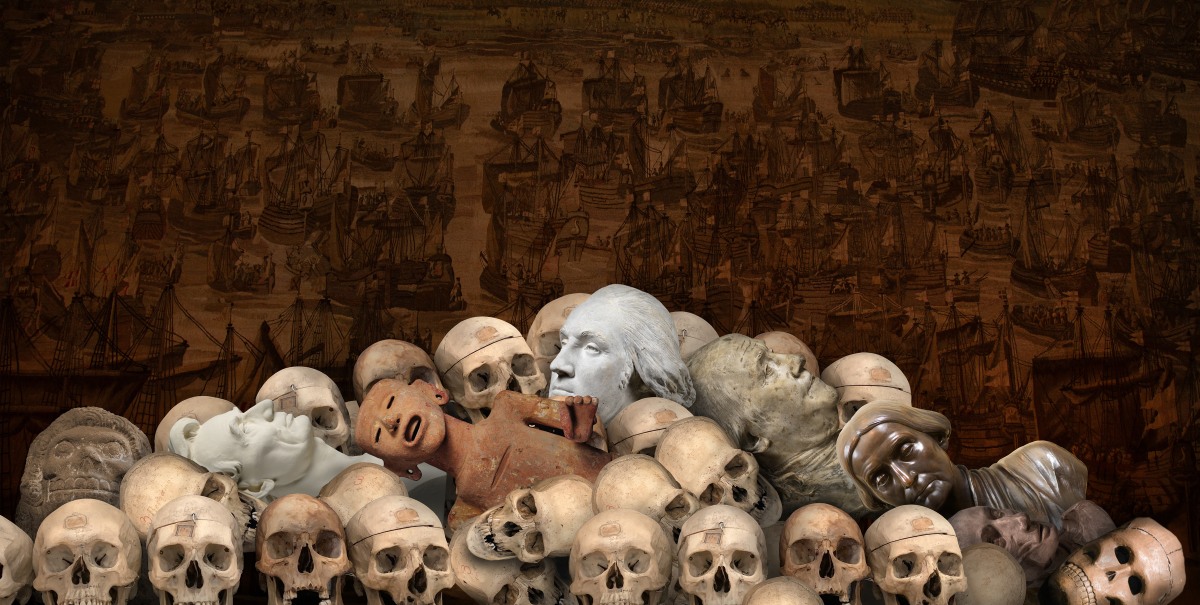
Ken Gonzales-Day
Afterlife (Digital composition with Mexico, Effigy of Death, National Museum of Anthropology (MNA), Mexico City; Leonard Wells Volk, Abraham Lincoln, Smithsonian National Portrait Gallery (NGP); Mexico, Aztec, Figure of Xipe Totec, LACMA; Jean-Antoine Houdon, George Washington, NPG; Houdon, Benjamin Franklin, NPG; Adelaide Johnson, Susan B. Anthony, NPG; Mexico,Scull Mask, MNA; Jean-Antoine Houdon, Flayed Man; Sculls, Museum of Criminal Anthropology, Turin; Rosenborg Tapestries, Rosenborg Castle, Copenhagen), 2025
Archival ink on rag paper
40 x 80 in (101.6 x 203.2 cm)
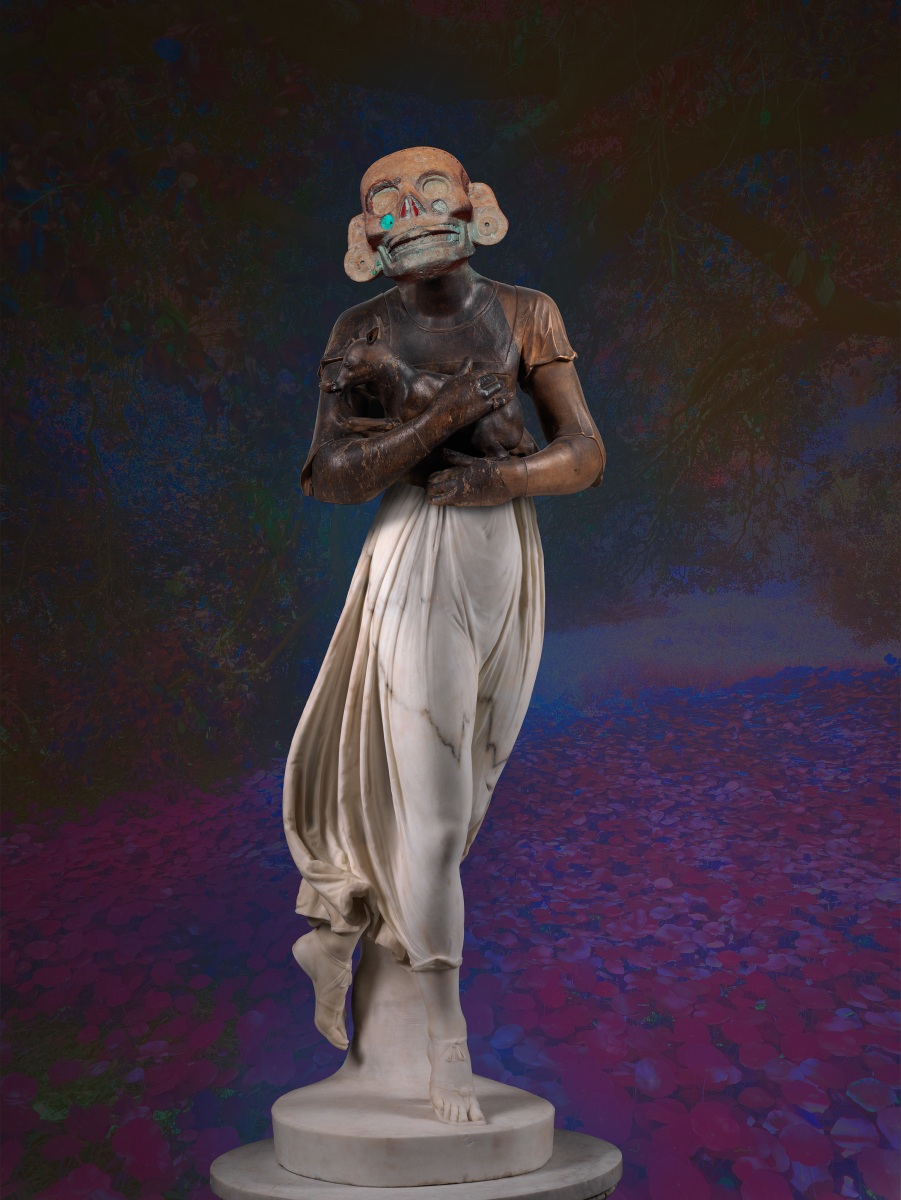
Ken Gonzales-Day
Dolor (Digital composition with, Nayarit, Hollow Figure, National Museum of Anthropology, Mexico City; Clemente Islas Allende, Dolor, National Art Museum, Mexico City; Plaster Copies of Roman Copies, Royall Cast Collection, Copenhagen), 2025
Archival ink on rag paper
16 x 20 in (40.6 x 50.8 cm) Framed
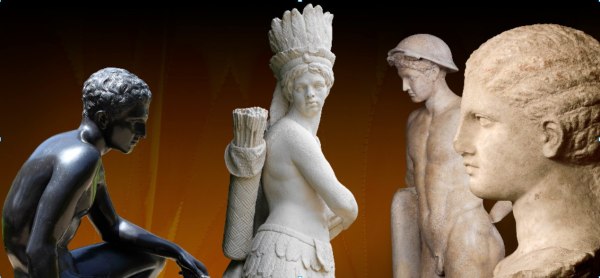
Ken Gonzales-Day
America (Digital composition with Unknown, Seated Hermes, reproduction of a Roman bronze sculpture from Villa dei Papiri, Herculaneum, The J. Paul Getty Museum, Villa Collection, Malibu; Gilles Guérin and Henri Émericq, L’Amérique, copy after the original, Versailles, France; Roman, after Greek original, The Bateman Mercury, William Randolph Hearst Collection, LACMA, Los Angeles; Unknown, Athens, Greece, Head of a Young Woman from a Grave Naiskos, The J. Paul Getty Museum, Villa Collection, Malibu), 2024
Archival ink on rag paper
26 x 52 in (66 x 132.1 cm)
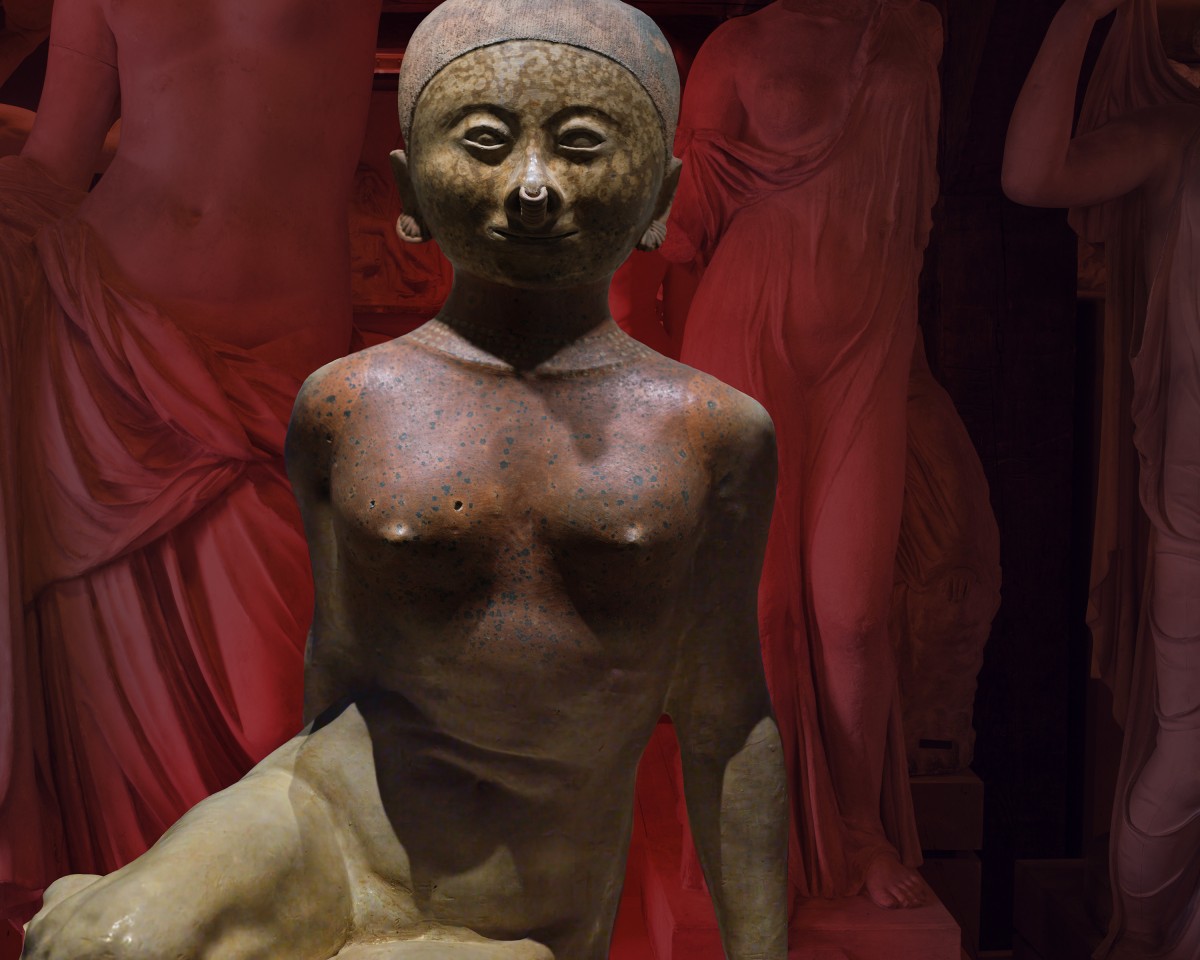
Ken Gonzales-Day
Dolor (Digital composition with, Nayarit, Hollow Figure, National Museum of Anthropology, Mexico City; Clemente Islas Allende, Dolor, National Art Museum, Mexico City; Plaster Copies of Roman Copies, Royall Cast Collection, Copenhagen), 2025
Archival ink on rag paper
16 x 20 in (40.6 x 50.8 cm) Framed
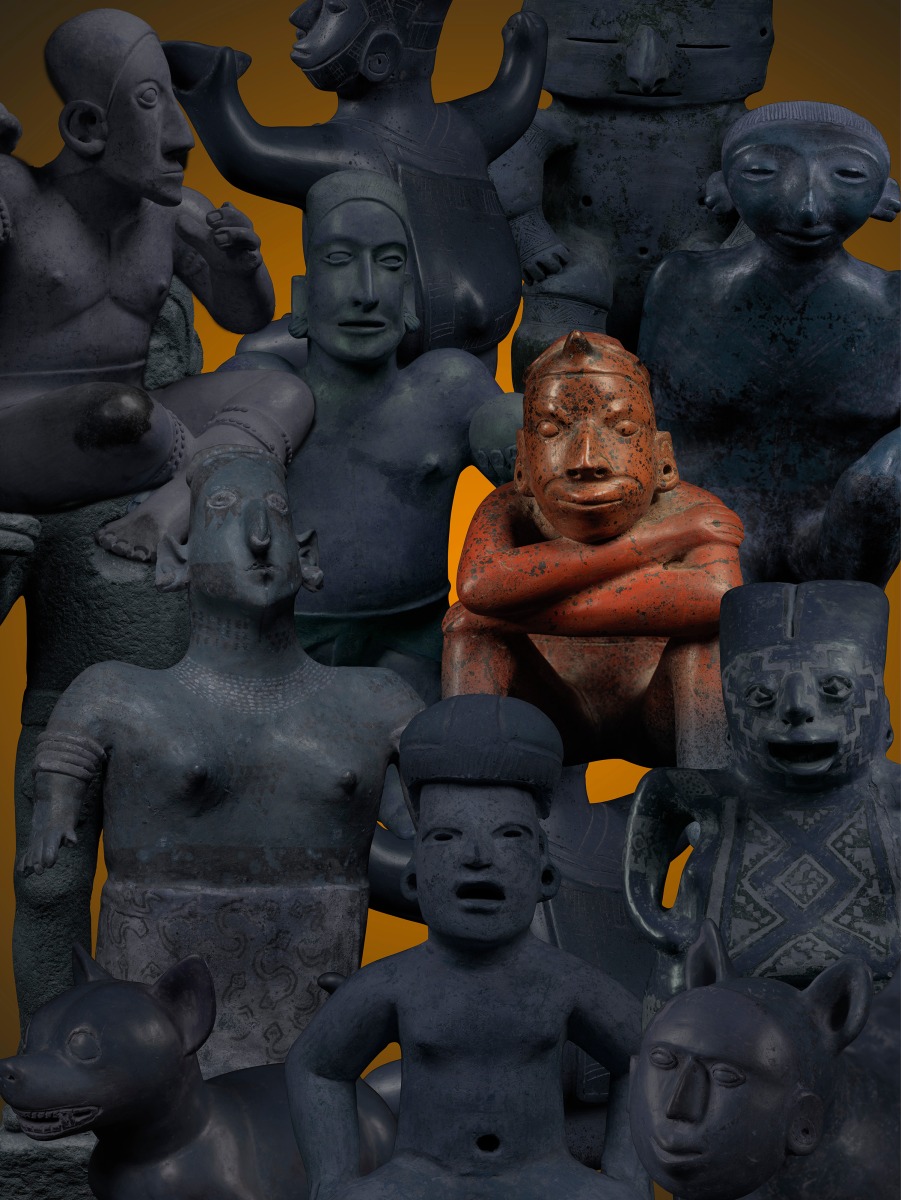
Ken Gonzales-Day
Guardian I (Digital composition with Mexico, Jalisco, Seated Male Figure; Mexico, Colima, Figural Vessel of Hunchbacked Male Drinker; Colombia, Middle Cauca, Caldas, Figure with Ligatures; Mexico, Nayarit, Seated Female Figure; Mexico, Jalisco; Standing Male Figure; Mexico, Colima, Seated Male Figure; Mexico, Nayarit, Standing Female Figure; Mexico, Tlatilco, Seated Figure; Mexico, Guanajuato, Acámbaro Valley, Chupícuaro, Standing Female Figure; Mexico, Colima, Standing Dog; Mexico, Colima
Dog with Human Mask, All LACMA), 2025
Archival ink on rag paper
40 x 30 in (101.6 x 76.2 cm)
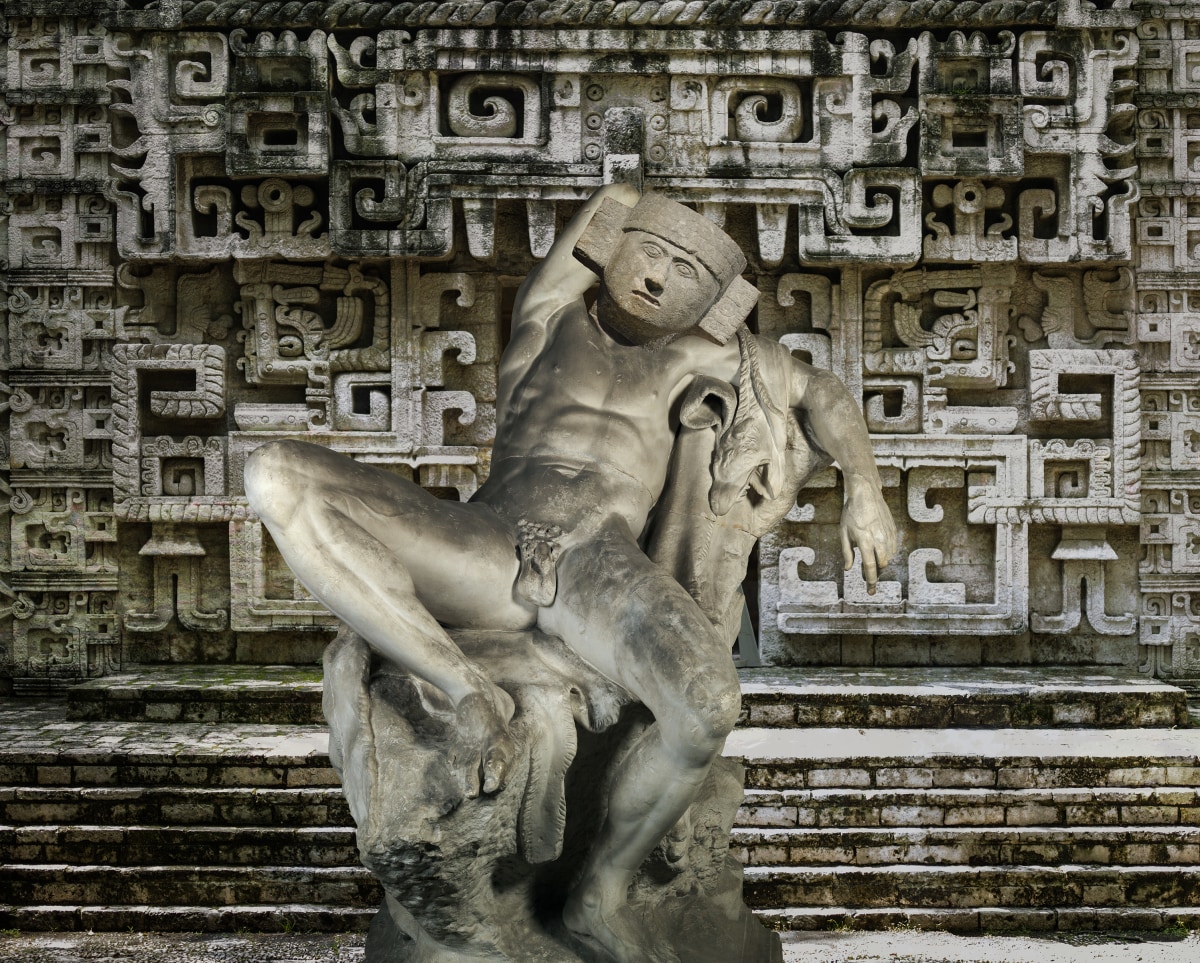
Ken Gonzales-Day
Mexica Barberini (Digital composition with, Plaster copy of Hellenistic, The Barberini Faun a.k.a. “Drunken Satyr,” Royal Cast Collection, Copenhagen; Mexica, Head of Choc Mool; Mexico, Recreation of Mayan Temple, National Museum of Anthropology, Mexico City), 2025
Archival ink on rag paper
20 x 16 in (50.8 x 40.6 cm)
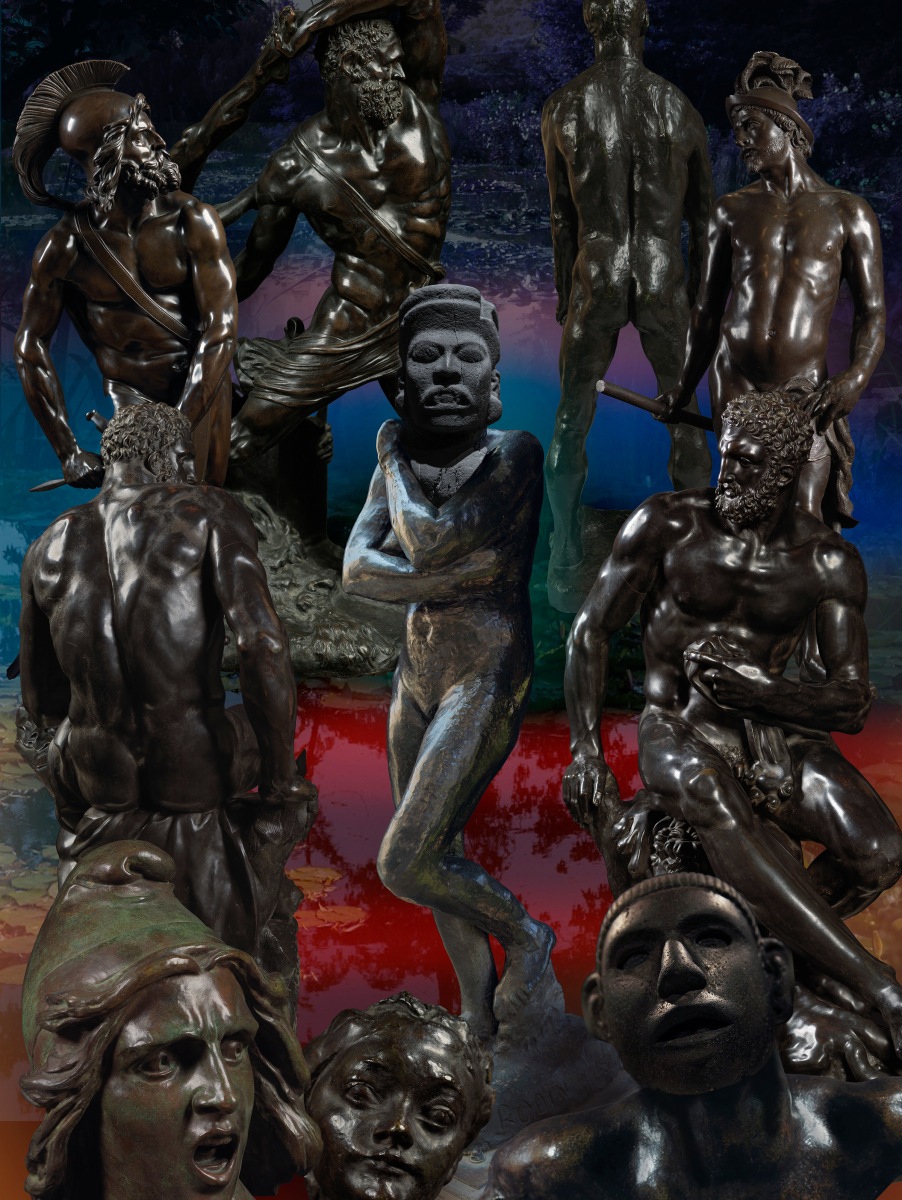
Ken Gonzales-Day
Origin (Digital composition with Pierre-Jean David d'Angers, Philopoemen; Antonio Canova, Hercules and Lychas; August Rodin, Nude Study for Jean D’Aire; Hendrick de Keyser (circle of) Mars; Guillaume Boichot, Seated Hercules; August Rodin, Eve, with Mexico, Huasteca, Head of Female Figure, National Museum of Anthropology, Mexico City; Guillaume Boichot, Seated Hercules; François Rude, Head of the Genius of Liberty; Rodin, Head of a Girl; Rodin, The Cry, composited with Quetzalcoatl-Ehecatl Mask, Museum of Ethnology, Berlin; all LACMA, unless noted), 2025
Archival ink on rag paper
53 x 40 in (134.6 x 101.6 cm)
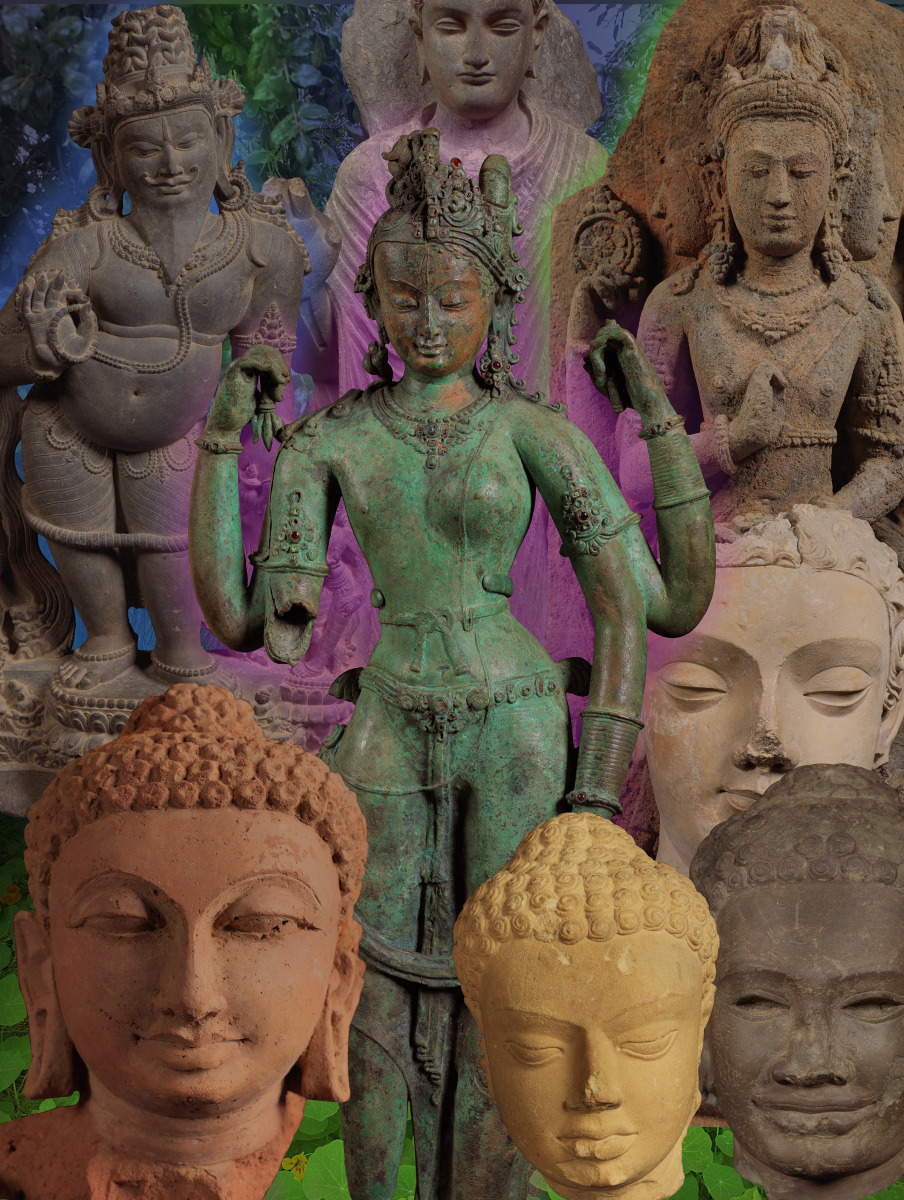
Ken Gonzales-Day
Shiva (Digital composition with India, Bihar, Lakhi Sarai, The Maharishi (Great Sage) Agastya; Pakistan, Gandhara region, Buddha Shakyamuni; Indonesia, Central Java, Brahma, The God of Creation; Nepal, The Androgynous Form of Shiva and Parvati (Ardhanarishvara); Pakistan or Afghanistan, Gandhara region, Head of Buddha Shakyamuni; India, Gujarat, Devni Mori, Head of Buddha Shakyamuni; India, Uttar Pradesh, Sarnath, Head of Buddha Shakyamuni; Cambodia, Head of Buddha Shakyamuni; all LACMA), 2025
Archival ink on rag paper
40 x 30 in (101.6 x 76.2 cm)
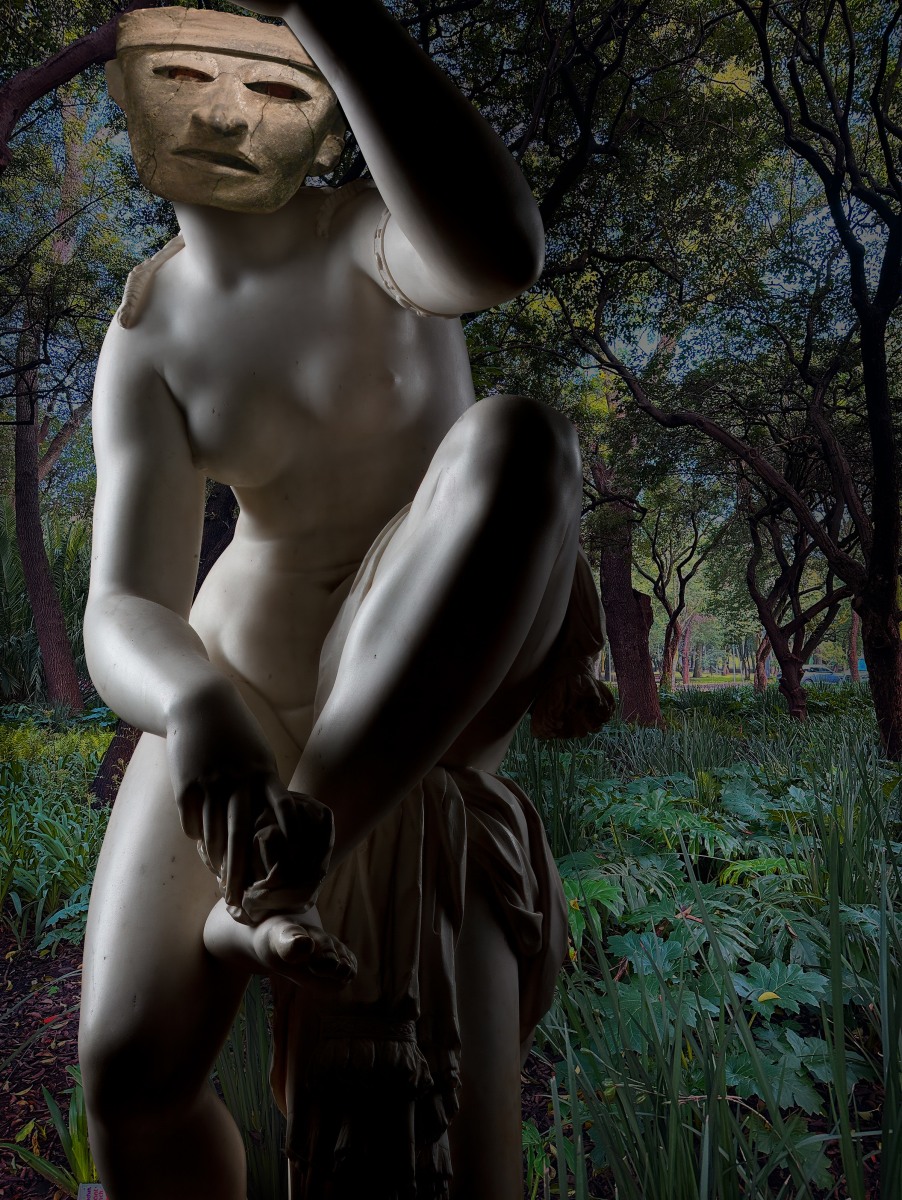
Ken Gonzales-Day
Venus (Digital composition with Aztec, Mask, Anahuacalli Museum, Mexico City; Giambologna, Female Figure, Possibly Venus, J. Paul Getty Museum; Tamayo Park, Mexico City), 2025
Archival ink on rag paper
40 x 30 in (101.6 x 76.2 cm)
Luis De Jesus Los Angeles is pleased to announce Ken Gonzales-Day: Afterlife, the artist’s sixth solo exhibition, on view in Gallery 1 and Gallery 2 from November 8 through December 20, 2025. An opening reception will take place on Saturday, November 8, from 4:00 to 7:00 pm.
Known for his conceptually driven photography and his investigations into race and historical memory, Gonzales-Day presents a new body of work that underscores the vital role of museum collections in celebrating the breadth of human experience. Drawing on his own cultural influences, he brings together objects from the Mexica and broader Mesoamerican traditions with those from Europe, Africa and Asia, foregrounding his intersectional perspective as a Queer Latinx artist. The exhibition's title, Afterlife, evokes the enduring afterlife of cultural objects, as both artistic expressions and historical artifacts within a larger cultural framework, while challenging the traditional narratives presented in museums.
Over the past 20 years, Gonzales-Day has photographed objects in museum collections and digitally reassembled them into new works. By combining these objects, Gonzales-Day creates playful and sometimes haunting images that are both timely and timeless, encouraging us to see our interconnectedness. The exhibition’s central piece, a large-scale photographic mural titled Xipe Totec with Busts, brings together images of busts of George Washington, Abraham Lincoln, Benjamin Franklin, and Susan B. Anthony (photographed during his residency at the Smithsonian American Art Museum and National Portrait Gallery) with Mexica and Mesoamerican objects, set amongst a deathly pile of skulls from the Museum of Criminal Anthropology in Turin. The work may incite reflection on the precarious state of museums and the battles being fought on both the cultural and global fronts.
Another series of works draw their inspiration from LACMA’s permanent collection, which served as the basis for the creation of a recently completed monumental public work entitled, Urban Excavation: Ancestors, Avatars, Bodhisattvas, Buddhas, Casts, Copies, Deities, Figures, Funerary Objects, Gods, Guardians, Mermaids, Metaphors, Mothers, Possessions, Sages, Spirits, Symbols, and Other Objects. It was commissioned by the Los Angeles MTA for the new D Line Subway Extension Wilshire/Fairfax Station. Here, Gonzales-Day uses museum objects as a starting point for artistic and cultural "excavation," aiming to recover and bring new life to works that may have been overlooked or silenced while also bringing attention to the lack of representation of Black, brown, queer, and other marginalized bodies in many museum collections, offering a critical and visual framework for rethinking these objects.
In another work, entitled Dying Gaul/Chac Mool, Gonzales-Day juxtaposes the iconic Dying Gaul, a Roman copy of a lost Greek original, humanizing a so-called barbarian, with a Mesoamerican Chac Mool figure, a reclining stone sculpture associated with rituals of sacrifice and renewal.
It is a portal between worlds and reminds us that the line between art and life can be hard to separate. The two works echo one another, but unlike the myth of Narcissus, evoked by the composition, the reflection suggests that something unseen and powerful lies just beneath the surface—a subtle reference to Latinx communities in the U.S.
Ken Gonzales-Day: AfterLife is complemented by the artist’s first survey exhibition, Ken Gonzales-Day, History’s Nevermade, curated by Dr. Amelia Jones, on view at the USC Fisher Museum of Art through March 2026. It includes a fully illustrated catalogue featuring essays by leading scholars in art history, Latinx Studies, and visual culture.
Ken Gonzales-Day (b. 1964, Santa Clara, CA) received his MFA in art from UC Irvine; his MA in art history from Hunter College, C.U.N.Y.; and was a Van Leer Fellow at the Whitney Museum’s Independent Study Program (ISP). Fellowships include: the Getty Research Institute (GRI), The Smithsonian SAAM fellowship in American Art, and the Smithsonian Artist Fellowship (SARF); The Terra Foundation in Giverny, France; The Rockefeller Foundation Center in Bellagio, Italy. Gonzales-Day has received fellowships and awards from Art Matters, The Avery Foundation, California Community Foundation, the Los Angeles' COLA award, Creative Capital Fellowship, and a Guggenheim in Photography.
His work has been widely exhibited and is in the permanent collections of the Los Angeles County Museum of Art, Los Angeles, CA; Museum of Contemporary Art, Los Angeles, CA; J. Paul Getty Museum, Los Angeles, CA; Getty Research Institute, Los Angeles, CA; Santa Barbara Museum of Art, CA; The National Gallery Art, Washington, DC; Smithsonian American Art Museum, Washington, DC; National Portrait Gallery, Washington, DC; Museum of Modern Art, New York; George Eastman Museum, Rochester, NY; Baltimore Museum of Art, Baltimore, MD; Norton Museum of Art, Palm Beach, FL; Art Institute of Chicago, Chicago, IL; Minnesota Museum of American Art, St. Paul, MN; Kalamazoo Institute of Art, Kalamazoo, MI; Eli and Edythe Broad Art Museum, Michigan State University, East Lansing, MI; Hood Museum of Art, Dartmouth College, Hanover, NH; The Art Museum of Dickinson College, Carlisle, PA; Middlebury College Museum of Art, Middlebury, VT; Williamson Gallery, Scripps College, Claremont, CA; Pomona College Museum of Art, CA; Art Gallery of New South Wales, Sydney; L'Ecole des Beaux-Arts, Paris; Musee National d'Histoire Naturelle, Paris; among others. Monographs include: Lynching in the West: 1850-1935 (Duke) and Profiled (LACMA, 2011), Surface Tension (Artist’s Book, 2017). Gonzales-Day received a Guggenheim Fellowship in photography in 2017, and has received fellowships and awards from Art Matters, COLA, California Community Foundation, Creative Capital, Smithsonian (SARF), The Rockefeller Foundation, and holds the Fletcher Jones Endowed Chair in Art at Scripps College.